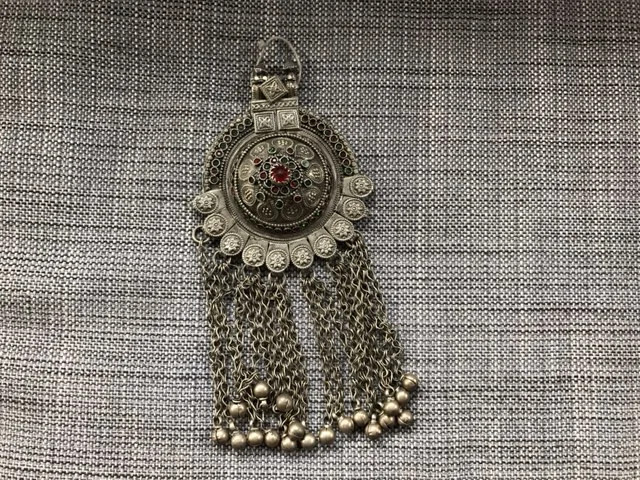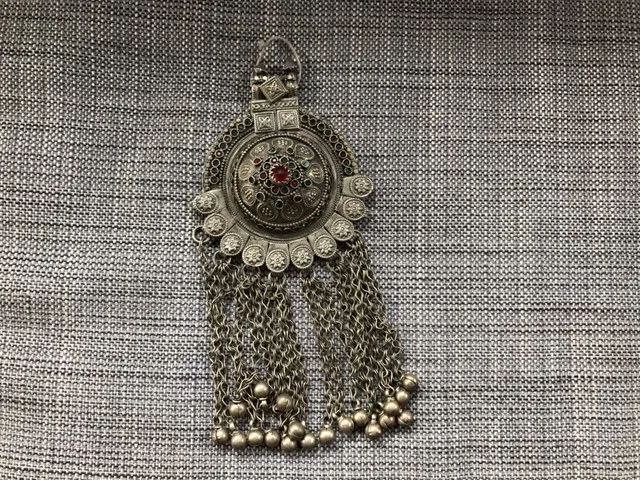The Afghani Kuchi Button from Islamabad, Pakistan
The Afghani Kuchi button shown above, was bought from a roadside jewelry stall in Islamabad, Pakistan. Today, it is one of the few places one can find Afghani jewelry for sale. Until a year ago, that was not the case. Afghani earrings, bangles, buttons, hair ornaments, and other traditional handicrafts steadily flooded the market starting the 1990s; last year, they all but disappeared. The story of this disappearance is not just one of demand and supply, but of global networks of slow violence and persecution.
According to Abdul Hameed*, the shop owner, the button belonged to a member of the Kuchi tribe. He acquired this piece, and other such artifacts, from a family that fled the country after the war. Of Afghani origin himself, Hameed’s trade is facilitated by his personal connections to friends and family in Afghanistan, some of whom belong to the Kuchi tribe. According to Hameed, the piece was handcrafted by Kuchi craftsmen in Eastern Afghanistan out of old, repurposed Kuchi components, gemstones and silver mined in the mountains of Badakhshan. The nomadic tribe wandered the mountainous region between Afghanistan and Pakistan with their caravans and herds up until the 1990s, following centuries old migration routes. The war put an end to this, and the nomadic lifestyle that came with it. The destruction and devastation forced the tribe to sell the only thing they owned to Abdul Hameed and others like him: their traditional jewels and handicrafts. Starting in the early 90s Abdul Hameed started smuggling these artifacts across the border into Pakistan, marketing them to locals and foreigners who frequented upscale shopping areas in the Islamabad. UN sanctions on Afghanistan during and after the war made it impossible to market these artifacts as Afghani. That is why a number of these items were discreetly labelled with “Made in Pakistan” stickers will into the early 2000s.
Recognizing the growing demand for authentic artifacts in Islamabad, Hameed capitalized on the opportunity and expanded his business, growing from a small shop in the corner of Supermarket to a large showroom. The demand grew steadily, giving rise to a new cottage industry. While a large percentage of the artifacts available in the market were still made in Afghanistan until the early 2000s, responding to the rising demand locally and internationally (Hameed became a wholesale dealer for collectors in Europe and the USA) in the following years a number of entrepreneurial dealers set up shop in Pakistan employing Afghani refugee craftsmen. Using remnants of old vintage pieces and traditional designs, along with new reproduction pendants and coins these craftsmen produced jewelry and other artifacts. The project was further aided by the large quantities of Lapis Lazuli, Kunzite, Emeralds, and semi-precious gems that became available as Afghan warlords liquidated their assets. Hameed was still able to procure and market vintage crafts from Afghanistan, but he also supplemented the flow of imports with local production. Hameed’s business thrived, and continued to grow.
Then in 2015, everything changed. Hameed’s expanding jewelry empire was reduced to a roadside jewelry stall. Pakistan became home to millions of displaced Afghan war migrants and refugees after the war. Most of these refugees were resettled in the Khyber Pakhtunkhwa in the North Western province, but a significant number settled in Islamabad, the capital. While the state did what it could to facilitate the resettlement effort, it was unable to provide housing to a large percentage of these refugees. Hameed’s network of importers and craftsmen hailed from this group. Stop gap arrangement, and temporary resettlement camps turned into permanent informal settlements nestled in the crevices of the gridded masterplan of the city. The inhabitants of a number of these settlements were deemed “illegal migrants” and forcibly evicted in August 2015 by the Capital Development Authority (CDA). The politics of Afghan resettlement and deportation have been discussed in another piece, link. While it is unclear where the inhabitants of these settlements eventually ended up, some sources claim they went back to Afghanistan, while others claim they relocated to other parts of the city. Hameed claims this to be the reason for the sudden downfall of his business, and other traders like him.
As the settlements disappeared, so did the network of local producers and importers that aided the flow of imports and production of artifacts. The supply dwindled, and demand for Afghan artifacts was replaced by the market for Chinese and Indian imitation jewelry. The local cottage industry died a swift death, and Afghan artifacts started disappearing from the market. Hameed’s enterprise was reduced to a roadside stall, while other such businesses perished altogether.
This button was one of the last pieces of Hameed’s old collection. It’s new home in Chicago is shared by others like it that reside in the Museum of the Art Institute in Chicago. In January 2015, Chicago collector Barbara Levy Kipper donated her collection of over 400 pieces of Asian art and artifacts to the Art Institute of Chicago. The collection boasts of a number of invaluable pieces from the Kuchi tribe. Museumized objects tell similar tales of slow violence and persecution, of occluded histories andsilenced pasts. But perhaps, that’s a tale for another time.
*Name changed for privacy.
Posted by: Javairia Shahid


